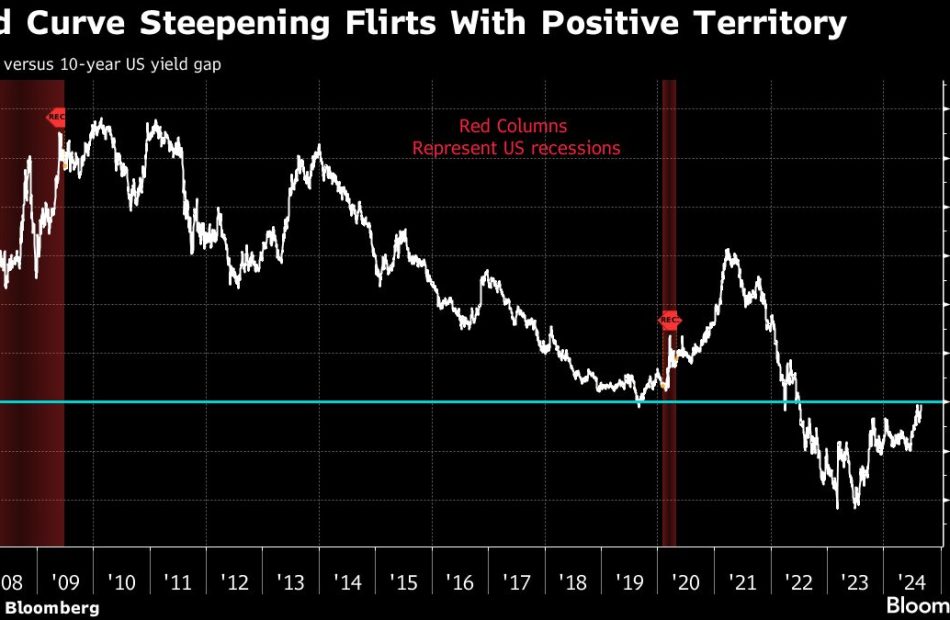S&P 500 Spikes in Last 10 Minutes of US Trading: Markets Wrap
(Bloomberg) — Stocks climbed in the final stretch of a wild August, with traders bracing for what’s historically known as the worst month for equities.
Most Read from Bloomberg
For all the whiplash in global markets just a few weeks ago, the S&P 500 closed within a whisker of its all-time highs. Equities spiked in the last 10 minutes of Wall Street trading, with the S&P 500 up 1% and all of its major groups on the rise. The gauge notched its fourth straight monthly gain amid data showing the economy is holding up, while leaving the door open for the Federal Reserve to start cutting rates in September. Whether a jumbo-sized reduction remains on the table, next week’s jobs report might bring some clues.
“As August comes to a close, sentiment has calmed down significantly compared to the beginning of the month,” said Mark Hackett at Nationwide. “Many of the larger concerns in the overall economy have decreased. September may bring some seasonal challenges, but if investors can navigate through them, these challenges can turn into advantages in the fourth quarter.”
Since 1950, the S&P 500 has generated an average loss 0.7% in September and finished higher only 43% of the time, making it the worst month for stocks on an average return and positivity-rate basis, according to Adam Turnquist LPL Financial. The last four Septembers have also been notably weak, with the index posting respective declines of 4.9%, 9.3%, 4.8%, and 3.9%.
“During the month, the index tends to trade sideways during the first half, with losses beginning to accumulate into month end,” he said. “For this year, the midway point also happens to line up closely with the September Fed meeting.”
The S&P 500 rose to around 5,650 ahead of Monday’s US holiday. The Nasdaq 100 added 1.3%. The Russell 2000 of small firms gained 0.7%. Goldman Sachs Group Inc. plans to dismiss a few hundred employees in coming weeks as part of the firm’s annual cull of low-performing staff, according to people familiar with the matter. Dell Technologies Inc. rallied on solid results.
Wall Street’s “fear gauge” — the VIX — dropped to 15. That’s after an unprecedented spike that took the index above 65 during the Aug. 5 market selloff. An options trader or traders bought call spreads on the VIX — expiring in September, spending upwards of $9 million to protect against a surge in the gauge of S&P 500 volatility past 22.
Treasury 10-year yields climbed five basis points to 3.91%. The dollar rose at the end of its worst month this year. Speculative traders turned bearish on the greenback for the first time since February. Oil tumbled.
Data from Bespoke Investment Group found that over the past 100 years, September also has by far been the worst month of the year for the Dow Jones Industrial Average with an average decline of 1.24%.
A Citigroup Inc. analysis of data since 1928 suggests S&P 500’s average realized volatility for September has historically been 1.5 points above August, while October has been an additional 2.5 points higher.
There are a few theories for why September tends to be a weaker month for stocks.
For one thing, investors returning from summer vacations tend to reassess portfolio positioning defensively. Companies prepare their budgets for the coming year and debate belt tightening. And mutual funds often engage in “window dressing” by selling positions at a loss to reduce the size of their capital-gains distributions.
“Additionally, companies entering a blackout period for share repurchases at the end of the third quarter can have their ability to support their share price impacted if the price drops,” Hackett said.
While seasonality can be reason enough for some jitters, 2024 is also an election year, Bespoke remarked. With that added potential cause for concern, September’s performance in election years has again, leaned negative, the firm said.
For all post-World War II presidential election years, the Dow has averaged a 0.58% decline during September. Albeit negative, that compares with September of non-election years when it has averaged an even larger 1.37%.
“In other words, seasonality has tended to be rough regardless of whether or not it’s an election year,” the Bespoke strategists noted.
For now, many traders are pinning their hopes on more data that will show the economy isn’t falling off a cliff, while inflation keeps marching toward the Fed’s 2% goal.
A report Friday showed US consumer sentiment improved for the first time in five months as slower inflation and prospects for Fed cuts helped lift expectations about personal finances. The Fed’s preferred measure of underlying US inflation — the core personal consumption expenditures price index — rose at a mild pace.
“This week’s numbers dispel worries about a recession and inflation,” said David Russell at TradeStation. “Goldilocks could be here as Jerome Powell prepares to turn the page.”
Powell said last week the time has come for the central bank to cut its key policy rate, affirming expectations that officials will begin lowering borrowing costs next month and making clear his intention to prevent further jobs cooling.
Like the Fed, investors’ focus seems to be shifting from inflation to the labor market, and soon all eyes will be on next Friday’s monthly jobs report, said Bret Kenwell at eToro.
“Last month’s jobs report was a big miss, causing widespread worry that the Fed was too late to cut rates,” he noted. “Another big miss could increase speculation of a 50 basis-point cut vs. the current expectation of a 25 basis-point cut.”
Swap contracts fully price in a quarter-point move and about 20% odds of the half-point cut forecast by at least two large US banks. They continue to almost fully price in a half-point rate cut at some point this year, anticipating cumulative easing of almost 100 basis points over the Fed’s three remaining policy meetings.
Stock markets are likely to benefit again from good economic data, which is needed for the rally to broaden out further beyond the tech sector, according to Barclays Plc strategists.
The team led by Emmanuel Cau says the monthly US jobs data next week will be the bellwether for confirming or refuting recession worries.
“If it is a bad print, no doubt equities would react badly given their level after the rebound,” they wrote. On the other hand, a better-than-expected figure would “help assuage those recession fears in the short run, and likely be good for equities.”
Cash funds recorded inflows of about $24.5 billion in the week through Aug. 28, a fourth straight week of additions, according to a note from Bank of America Corp., citing EPFR Global data. About $20.7 billion entered bond funds, while $13.7 billion flowed into stocks, the data showed.
US equities saw a ninth straight week of additions at $5.8 billion.
Corporate Highlights:
-
Tesla Inc. aims to unveil its highly anticipated robotaxi at an event at Warner Bros. Discovery Inc.’s movie studio in the Los Angeles area, people familiar with the matter said.
-
The electric vehicle company is targeting a reveal of the purpose-built robotaxi on Oct. 10 at the Burbank, California facility, said the people.
-
-
Intel Corp. is working with investment bankers to help navigate the most difficult period in its 56-year history, according to people familiar with the matter.
-
The company is discussing various scenarios, including a split of its product-design and manufacturing businesses, as well as which factory projects might potentially be scrapped, said the people.
-
-
Lululemon Athletica Inc. lowered its sales and profit outlook for the year as increased competition and relentless inflation curb demand for its pricey yoga pants.
-
Ulta Beauty Inc. trimmed its sales forecast as more US consumers cut back on makeup and cosmetics in the face of higher prices and elevated borrowing costs.
-
Autodesk Inc. raised its full-year earnings outlook following pressure on the software maker from activist investor Starboard Value LP.
-
Alnylam Pharmaceuticals Inc.’s trial of its drug to treat a deadly form of heart disease fell short of investors’ expectations.
Some of the main moves in markets:
Stocks
-
The S&P 500 rose 1% as of 4 p.m. New York time
-
The Nasdaq 100 rose 1.3%
-
The Dow Jones Industrial Average rose 0.6%
-
The MSCI World Index rose 0.8%
-
Bloomberg Magnificent 7 Total Return Index rose 1.6%
-
The Russell 2000 Index rose 0.7%
Currencies
-
The Bloomberg Dollar Spot Index rose 0.1%
-
The euro fell 0.2% to $1.1055
-
The British pound fell 0.3% to $1.3133
-
The Japanese yen fell 0.8% to 146.15 per dollar
Cryptocurrencies
-
Bitcoin fell 1.3% to $58,785.55
-
Ether fell 1.3% to $2,507.87
Bonds
-
The yield on 10-year Treasuries advanced five basis points to 3.91%
-
Germany’s 10-year yield advanced two basis points to 2.30%
-
Britain’s 10-year yield was little changed at 4.02%
Commodities
-
West Texas Intermediate crude fell 3% to $73.62 a barrel
-
Spot gold fell 0.7% to $2,503 an ounce
This story was produced with the assistance of Bloomberg Automation.
Most Read from Bloomberg Businessweek
©2024 Bloomberg L.P.




Leave a Reply